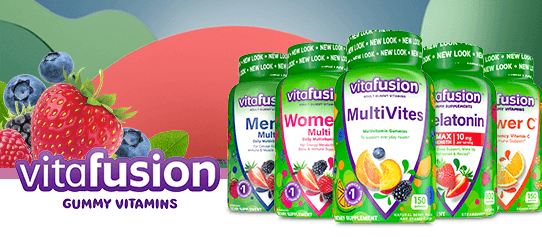
Alright, alright, alright… EVERYONE GO GET YOUR MULTIVITAMINS and let’s check those labels. Today we are mainly just going to look at Vitamin A, but it is important to note that there are MANY other vitamins that are important for our daily intake. I want to preface our activity by saying that supplements should be your LAST resort when making sure you are getting your daily recommended amounts of vitamins and supplements into your system. Diet should be the first place you go to make sure you are getting all of the nutrients your body needs. So today we will look at how much vitamin A is actually in our multivitamins (if it is even included in them at all), what Vitamin A is and what purpose it serves for our bodies, and take a look at a list of foods that are high in Vitamin A. The daily recommended amount of Vitamin A will be revealed at the end of this post.
Step 1: Get your multivitamins and look at those back labels. Today I will be looking at my vitafusion women’s multivitamin but you all may have different brands. The back label will look like this:

As you can see vitamin a is listed as having 450 mcg RAE and it is showing that that is 50% of the daily value. So first, what is mcg RAE. RAE stands for Retinol Activity Equivalents and mcg is microgram, which is the unit of measurement for Vitamin A. So now that we know what those numbers are and what those letters mean, we need to learn about what Vitamin A is and what purpose it serves for our bodies.

So what is Vitamin A? Vitamin A is retinol or retinoic acid. Retinol as some of you may know is a fat-soluble vitamin that is part of the vitamin A family. This nutrient is very important for our vision, cell division, growth, reproduction and immunity. TALK ABOUT PLAYING AN IMPORTANT ROLE! Retinol is used in a lot of anti-aging creams as well. Vitamin A also has some antioxidant properties. Antioxidants are substances that protect our cells when certain molecules are produced as a result of food being broken down, exposure to tobacco or radiation. These nasty molecules play a role in heart disease, cancer and other diseases. So obviously Vitamin A is very important for a variety of reasons and when your body is receiving this important nutrient on a daily basis for a long period of time you are ensuring that your body is getting what it needs to have stronger vision, proper growth etc etc. While Vitamin A is a family and has retinol and retinoic acid it is important to note the slight difference between the two.

Step 2: Eat foods high in Vitamin A!
Foods that contain Vitamin A:
- Sweet potato
- Kale
- Cooked Collards
- Turnip Greens
- Carrots
- Sweet red pepper
- Spinach
- Romaine lettuce
- Mango
- Canteloupe
- Grapefruit
- Watermelon
- Papaya
- Apricot
- Tangerine
- Nectarine
- Beef and lamb liver
- Liver sausage
- Cod liver oil
- Salmon
- Bluefin Tuna
- Goat cheese
- Butter
- Cheddar
- Limburger Cheese
- Hard-boiled eggs
- Trout
- Blue cheese
- Cream Cheese
- Feta cheese
As I mentioned before, Vitamin A is fat-soluble meaning it is best absorbed into the bloodstream when eaten with fat (ex: spinach with light butter mixed in OR a bit of oil added to your salad). Animal-sourced food rich with Vitamin A tend to already contain a significant amount of fat so additional fat is not needed for best absorption.
Step 3: If you aren’t eating enough foods that are high in Vitamin A, you should most definitely also include a Vitamin A supplement into your daily routine to ensure you are getting enough of this very important nutrient. If you aren’t eating any foods with Vitamin A, YOU NEED TO START INCORPORATING FOODS WITH VITAMIN A and most definitely include a Vitamin supplement as well.
Personally, I like to take individual supplements (no multivitamin) that incorporate only one or two vitamins because these individual supplements tend to have higher amounts of each vitamin, rather than only 50% of the daily recommended amounts found in multivitamins. Which brings me to my big reveal…..
How many mcg of Vitamin A do we need daily?!?! It is recommended that men receive 900 mcg of Vitamin A and women around 700 mcg PER DAY.

So how much are you lacking Vitamin A in your diet? Incorporating Vitamin A into your daily intake is JUST ONE of the ways you can take better care of yourself physically. When life gives us so many opportunities and blessings, why would we not treat our bodies better? When our bodies are on their A-Games (haha!) we have a fuller capacity to soak in the many wonderful things around us.
Have a blessed week!
Emma

